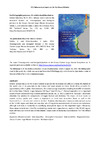Identificador persistente para citar o vincular este elemento:
https://accedacris.ulpgc.es/jspui/handle/10553/56276
| Campo DC | Valor | idioma |
|---|---|---|
| dc.contributor.author | Gelado-Caballero, M. D. | en_US |
| dc.date.accessioned | 2019-07-30T07:45:32Z | - |
| dc.date.available | 2019-07-30T07:45:32Z | - |
| dc.date.issued | 2015 | en_US |
| dc.identifier.uri | https://accedacris.ulpgc.es/handle/10553/56276 | - |
| dc.description.abstract | Mineral aerosol inputs to the Canary Current Large Marine Ecosystem (CCLME) are among the highest in the world, due to its proximity to the Sahara and Sahel deserts in Africa. North Africa accounts for approximately 55% of global dust emissions. An annual average deposition resulting from different models for the Northeast Atlantic ranges between 140 Tg yr‐1 and 276 Tg yr‐1. Aerosol deposition is an important source of essential and limiting nutrients and trace metals (Fe, Co, Mn, Cu and Al) to the ocean, which may stimulate the autotrophic components (nitrogen fixation and diatoms). The impact of dust inputs on oceanic carbon uptake and climate is dependent on total dust deposition fluxes as well as the bioavailability of nutrients and metals in the dust. However, dust deposition measurements are very scarce in the CCLME region and there are very few sets of long‐term measurements of aerosol concentrations, although such data is invaluable in quantifying atmospheric inputs to this important region. Moreover, these measurements are critical for constraining climate and biogeochemical models in the CCLME region, especially because the land use and the climate change could be increasing dust emissions from the African sources. | en_US |
| dc.language | eng | en_US |
| dc.relation | "Macsimar" Incorporación Del Sistema Integrado de Monitorización Meteorológica y Oceanográfica de Macaronesia en la Estrategia de Investigación Marina/Marítima Europea | en_US |
| dc.relation | Estramar-Estrategia Marino-Marítima de I+D+I en la Macaronesia | en_US |
| dc.source | Oceanographic and biological features in the Canary Current Large Marine Ecosystem / Valdés, L. and Déniz‐González, I. (eds). IOC‐UNESCO, Paris. IOC Technical Series, No. 115, p. 53‐61 | en_US |
| dc.subject | 590208 Política del medio ambiente | en_US |
| dc.subject | 2510 Oceanografía | en_US |
| dc.subject.other | Mineral aerosols | en_US |
| dc.subject.other | Dust deposition | en_US |
| dc.subject.other | Atmospheric transport | en_US |
| dc.subject.other | Dust variability | en_US |
| dc.subject.other | Biogeochemistry | en_US |
| dc.subject.other | Canary Current Large Marine Ecosystem | en_US |
| dc.subject.other | Northwest Africa | en_US |
| dc.title | Saharan dust inputs to the Northeast Atlantic | en_US |
| dc.type | info:eu-repo/semantics/bookPart | en_US |
| dc.type | BookPart | en_US |
| dc.investigacion | Ciencias | en_US |
| dc.type2 | Capítulo de libro | en_US |
| dc.identifier.ulpgc | Sí | es |
| item.grantfulltext | open | - |
| item.fulltext | Con texto completo | - |
| crisitem.project.principalinvestigator | Gelado Caballero, María Dolores | - |
| crisitem.project.principalinvestigator | Gelado Caballero, María Dolores | - |
| crisitem.author.dept | GIR Tecnologías, Gestión y Biogeoquímica Ambiental | - |
| crisitem.author.dept | Departamento de Química | - |
| crisitem.author.orcid | 0000-0003-4001-9673 | - |
| crisitem.author.parentorg | Departamento de Química | - |
| crisitem.author.fullName | Gelado Caballero, María Dolores | - |
| Colección: | Capítulo de libro | |
Visitas
187
actualizado el 12-jul-2025
Descargas
191
actualizado el 12-jul-2025
Google ScholarTM
Verifica
Comparte
Exporta metadatos
Los elementos en ULPGC accedaCRIS están protegidos por derechos de autor con todos los derechos reservados, a menos que se indique lo contrario.
